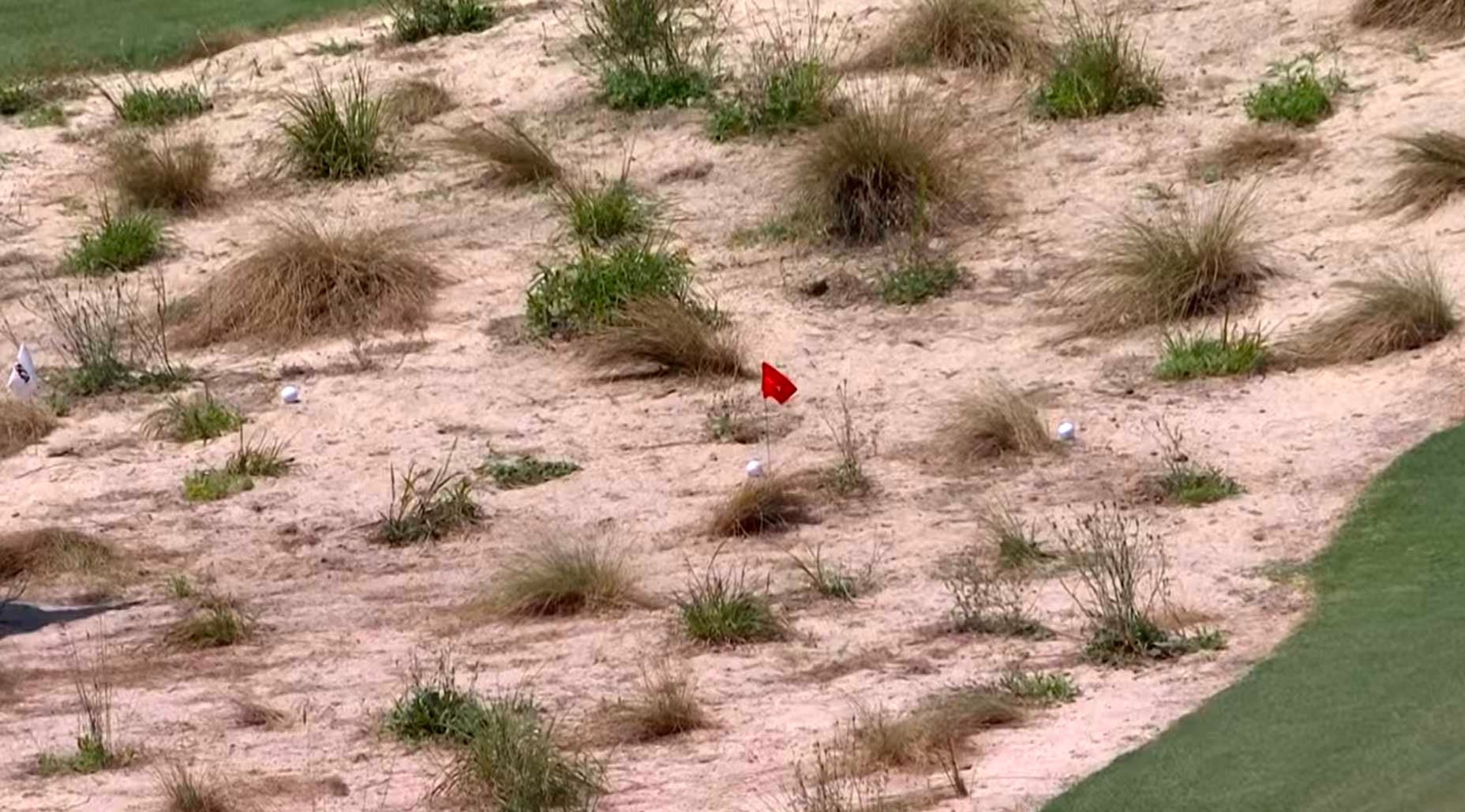Entertainment
This U.S. open is brutal entertainment — and we can’t look away

Jason Day reacts after a shot during the U.S. Open at Pinehurst No. 2.
Getty Images
PINEHURST, N.C. — A funny moment happened Thursday at the U.S. Open.
You may have seen the clip. As if they were playing H-O-R-S-E, this tournament’s super-group — Rory McIlroy, Scottie Scheffler and Xander Schauffele — all played nearly identical approaches into the par-5 5th. One after the other they all peppered the left side of the green, trickled off the side and slid down into the native area, one of the worst places for your golf ball to come to a stop in all of North Carolina.
What ensued was the three best players facing one of the trickiest up-and-downs of the season — and all failing. McIlroy earned the highest marks for skidding one through the green and two-putting for par. The other two flubbed their tries and made off with double bogeys, seriously denting their chances of winning.
It was a reminder — abrupt and harsh — that there are places at Pinehurst where 4 and 5 and 6 and 7 (and 8 and 9) are all plausible scores. Where the skills of the best golfers in the world are not enough. They have to turn into the best thinkers in the world, too. And when they do, they become some of the most entertaining athletes in the world. Entertainment. It’s how eyeballs get turned into the money they’re all playing for. We’ve been talking about it in this sport more than ever before.
That moment stands out because it brought the media center to a standstill. Bathroom breaks were postponed. Lunch runs were paused. It was immediate, appointment television, even for the folks who watch this sport as much as anyone. (The only problem for us is that it’s happening all over the property, but that’s kind of the point.) Golf is a difficult sport to broadcast. Capturing the essence of a 156-player tournament through long range camera lenses in towers littered all over makes storytelling tricky. Which is why it’s so important that the biggest events are played on its most thought-provoking golf courses. It’s vital to our sport. Where the Super Bowl or Final Four is played doesn’t really matter. Where golf majors are held is everything! And we’ve never had a display quite like the current major compared to the last one.
That tournament saw Xander Schauffele win at a record 21-under par. New record! How thrilling!
Wrong.
Schauffele’s win was not thrilling because of the scores he shot but because of the story — often the bridesmaid, rarely the bride. That all changed! But the tournament became thrilling because of the interesting and entertaining person whose score was separated from Schauffele’s by just one. The guy who practices chip-in reactions on a quest to become (or continue being) the sport’s greatest entertainer: Bryson DeChambeau.
If we think about golf like the math equation it is, then Valhalla was way more Algebra than Calculus — there were barely any variables. And unlike any other sport, Golf on TV thrives on variability. Rules issues. Waffling between clubs. Wind, rain, firmness, rough and all that other stuff that arises once a tournament or once a month. Valhalla’s variables went out the window when when Mother Nature allowed the ball to sit in the fairways and on the greens wherever they first landed. Hit it here, it’ll stay here. Hit it there, it’ll stay there. For the best golfers — more athletically advanced than previous eras, using equipment designed to test boundaries — they will hit it there and assume it stays there. The results narrow. But at Pinehurst — and most U.S. Opens — players face the constant threat of going backwards.
Using first round data between the U.S. Open and the PGA, there were more eagles here (10 to 4), half as many birdies, the same amount of pars, a lot more bogeys, a lot more doubles, and a lot more “others”. On paper, it’s just numbers. On a chart, it’s a flatter (and wider) bell curve of results. But on the internet it’s more blog posts, more tweets and more highlights. Those things create their own vortex that drives a goal everyone in the sport cares about: higher viewership.
Golf with a wider set of results creates emotion in the players trying their best to be stoic, unbothered, controlled and patient, and nothing draws us in like emotion. Whether pros like it or not, the non-pars pull our heads up from our phones, just like car crashes push NASCAR fans forward in their seats. It’s why the most thrilling Tour de France stages feature cyclists ripping their Treks through a tiny town with tighter-than-normal corners and cobblestone streets. Is it any wonder why golf writers and broadcasters often refer to a triple bogey as a wreck? You can’t look away because it might just get worse.
Whenever a golf ball skirts along the edge of the fairway and slides into the native areas at Pinehurst, that’s what’s happening. We’re leaning forward. The roulette table is spinning. We’re delaying dinner. The same goes for shots that land in the wrong section of greens, or when putts are struck too firm. When a player ping-pongs from one side to the other, or can’t control their wedge spin.
“You’re going to have super highs and super lows,” said Bryson DeChambeau (famously a numbers man) after his second round. “I just saw when we were on 10, Sepp Straka made a hole-in-one, right? Right behind us. That was a high, super high, and it was really cool to feed off that energy. Then I see guys ping-ponging it around the greens out here, and it’s like, I don’t want to watch that.”
He doesn’t want to watch that because he’s playing the tournament. But we want to watch that. It’s relatable. It’s abnormal. It evokes embarrassment and angst and empathy, freezing you in place until the ball finally reaches the bottom of the cup. We don’t know what it’s like to reach 200 mph ball-speed but we do know all those emotions.
DeChambeau seems to understand that more than most, and maybe more than he used to. He has spent the last year talking about himself as an entertainer via golf and thinks of his work as entertainment via competition. He doesn’t just have an extremely active YouTube account, he’s the only guy in the field with his YouTube handle printed on his golf bag. (It wasn’t shocking that, after his second exhausting walk around Pinehust, he was planted in front of a camera to offer some pro-bono commentating with Smylie Kaufman.)
Super high-highs and super low-lows is such an eyes-wide-open observation during a week where players seek the straight-and-narrow. You don’t get this at every event on the PGA Tour, and you wouldn’t want it at every event. (I’m not sure the players would survive.) But we need it in majors, the four times a year where bad vs. good vs. great exists on a razor’s edge. We just didn’t get that last month.
Think back two months to what the Masters looked like in April, the firmest Augusta National has played in years, if not decades. Masters veterans promised they’d never seen it play like that way. Max Homa’s 8-iron on Sunday traveled one yard too far and ended his tournament at Amen Corner. He conquered the course for 3.75 rounds, but not four. It made you want to watch him the next time out, and it made you want to Google search his thoughts after the round.
I chatted with Homa’s caddie, Joe Greiner, on Wednesday, as his man prepared for one final practice loop around this course. Caddies like Greiner enjoy weeks like this one, even if they, too, can get flustered by the volatility. Why? They’re unquestionably more involved. Answering more questions and keeping more figures. It’s not just carry yardages, but rollout yardages and super-rollout yardages. Thin yardages, too. They are so puzzled by the lines players need to take off the tees that they work together more than other weeks. Early in our conversation, Greiner admitted that these sickening weeks of confusion are more fun than the status quo, but later corrected himself.
“It isn’t more fun. It’s more rewarding.”
Ain’t that entertaining? At the end of this weekend in Pinehurst, the entire top 10 is going to feel a special kind of reward they didn’t really feel at the PGA. For toiling through the chaos and amusing us for four wretched days without even trying to. And all of us will be thankful at the end of it.













